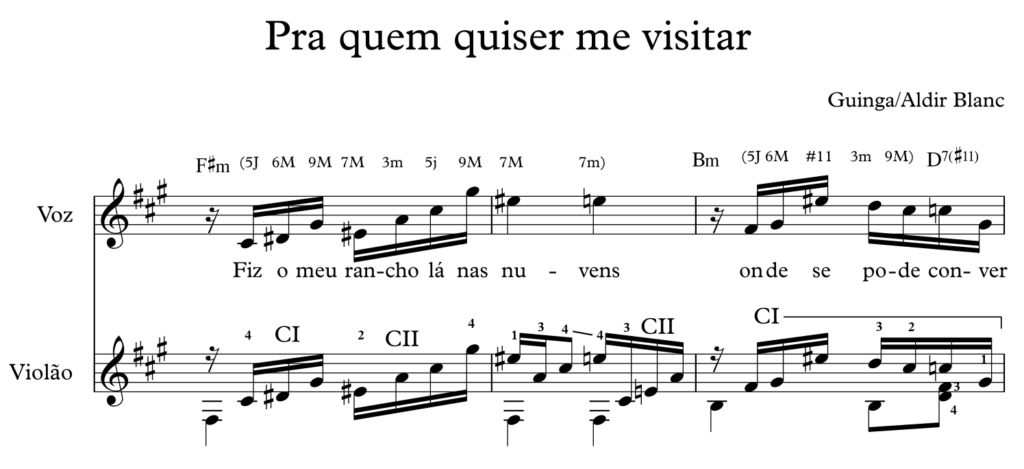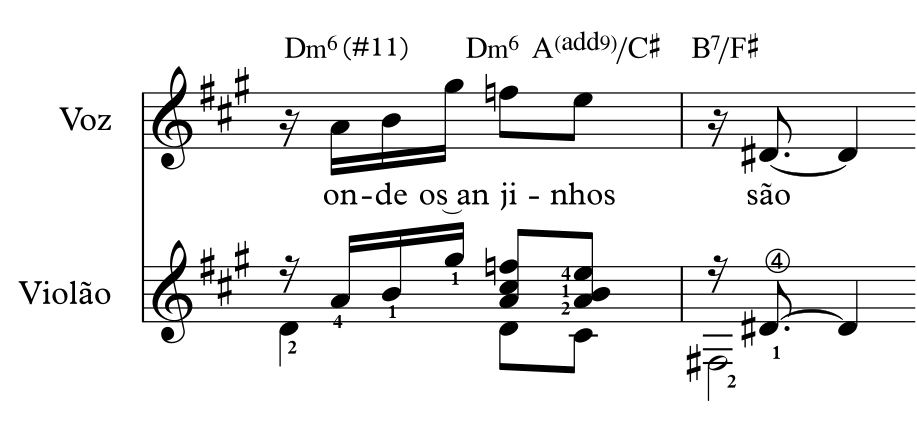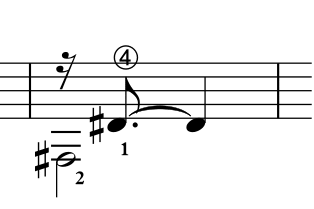3.7 – the guitar sometimes brings the melody
SARAIVA
00:00 building assimilation
GUINGA
00:49 Noturna (Guinga/Paulo César Pinheiro)
01:20 decides when the song starts
SARAIVA
02:03 passages from Pra quem quiser me visitar (Guinga/Aldir Blanc)
GUINGA
That is funny, but it is in fact unconscious.
You, who are a composer, know it.
SARAIVA
Yeah…we keep on doing…
for example, here when…
[plays and sings highlighting part of Pra quem quiser me visitar]

[afterwards just sings the same part highlighting the bar changing interval between E (fifth in A chord (add9)/C#) and D# (third in B7 chord), which form an interval of minor ninth [i] of difficult vocal intonation.

it gives me the impression that if finger “1” were not here…

… that would not be the melody note.
GUINGA
Ah, it wouldn’t.
The guitar sometimes brings the melody.
SARAIVA
It provides, doesn’t it?
GUINGA
But actually it is the fact that you are trying to find it unconsciously on the guitar.
But sometimes you make a mistake, and the mistake if for the better, and then you take advantage of that mistake.
That happens a lot to the composer.
The thing that Guinga classifies as a mistake, in his own consideration of popular song, is trivial in other musical languages also present in the wide scope of resources he uses such as, for example, those that come from compositional lines of written music for solo guitar in the modern period. Such an aesthetic convergence, which was, as we see, one of the key points of the study, has revealed some displacement from Luiz Tatit’s position in relation to the question. In the first interview (carried out on Oct 3, 2011) which gave basis to the dissertation, Tatit classifies Guinga’s melodies, as a whole, as constituted of material taken from “instrumental origin” matrix.
TATIT
Guinga, for example,
extracts melodies that turn out to become singing units
but that have another origin, which is instrumental.
The instrument suggests a line,
and if the line is too much instrumental,
it comes to be diminished.
You soften the musicality
so that it becomes something chantable.
On May 28, 2015, a second interview was held to be inserted in the movie Violão-Canção: uma alma brasileira (Guitar-Song: a Brazilian soul), an unfolding of the dissertation thesis [i] . At this second moment, mobilized by the live performance of the initial melodic motif of Guinga’s song – which expresses the aspect that has been discussed in the format of music —, Luiz Tatit updates and deepens his perception about the topic by stressing the presence of what is inherent to the speech – the departure point of Tatit’s listening – in what has already or could be seen as strictly instrumental. The melody, permeated by occurring accidents, is markedly dissonant in relation to the used tonality; its course is composed of intervals of difficult intonation, at least for a singer forged in the popular song tradition, and even though, Tatit listens to it then as a melodic phrase that has a “very strong chanting foundation” and highlights the co-existence of “both systems”.
SARAIVA
00:00 half way
00:00 Pra quem quiser me visitar (Guinga/Aldir Blanc)
[plays and sings]
TATIT
[comments just after the musical execution]
00:00 intonation taking the possible path
Interesting this phrase
it has a very strong intonative foundation,
and at the same time it is a super weird melodic way, so new,
just like taking a completely original path,
but with a very clear chanting behind, a very clear chanting.
So it is interesting because it is there where the two systems enter,
the harmonic part suggesting a way that is different
and at the same time the chanting taking a possible path. [i]
-
What would be descent chromaticism, easily chanted, becomes a minor ninth chord interval with the eighth break – possibly suggested by the register of the fourth guitar string – which makes the intonation difficult.
-
- Medium-length film, launched in 2016, produced with PRCEU/USP resources, co-directed by Prof. Dr. Rose Satiko Gitirana Hikiji, in partnership with Laboratório de Imagem e Som da Antropologia (LISA/USP).
-
LINK for the video at this moment, which ends the chapter – 3.4 -“The question of Tatit”.